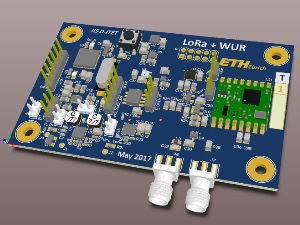WuLoRa: Energy-Efficient IoT Sensor Node
Overview
As my second semester thesis at ETH Zürich, I participated in the development of an energy-efficient IoT sensor node called WuLoRa. My tasks were to debug and evaluate the preliminary prototype, completely redesign the hardware, develop testing firmware and perform extensive analysis, including power measurements for numerous scenarios. The full report can be downloaded below.
Major features of the WuLoRa sensor node:
- Combination of ultra-low power wake-up circuit with long range transceiver to achieve low-latency communication and maintain low power consumption
- Nanopower always-on wake-up circuit with address matching
- Semtech SX1276 LoRa radio module
- Dual MCU platform: TI MSP430 microcontroller equipped with FRAM and Microchip PIC12LF1552 microcontroller
- Various sensors, including temperature, humidity, barometric infrared and light sensors; 9-axis intertial measurement unit (IMU)
- Battery-operation with energy harvesting option
- Battery gas gauge
Abstract
Computational performance has been steadily increasing in embedded systems for the last decades, which has led to emerging number of installed Internet-of-Things (IoT) devices and applications. Although hardware technology has been developing in a steep manner, battery technology has been stagnating. Therefore, low-power system design has become the most important development aspect of battery-powered embedded systems. IoT devices capable of wireless communication have to balance between network latency and battery life. One method for achieving low energy consumption is to implement heavy duty cycling of the radio module. However, putting the radio in sleep mode for long intervals greatly affects the communication latency of the node. High latency is unacceptable in safety-critical systems. In order to overcome this issue, a new, emerging technology is utilized. This state-of-the-art technology incorporates the use of an always-on wake-up radio alongside with a long-range radio transceiver. The goal of this project is do develop a new, state-of-the-art, LoRa-enabled IoT platform with a nanowatt wake-up radio; where network latency is minimized without sacrificing battery life.
Report
Please note that the file size of full report is approximately 9MB, thus it may take some time to download.
Pictures

